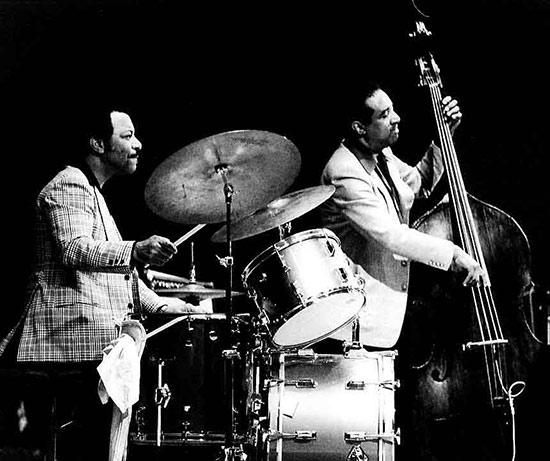Groove is the most misunderstood concept in music. A lot of things have to fall into place for a groove to happen. Groove is not singular but collective. It is impossible for a groove to occur if the musicians are not in sync with one another.
Time is a musical constant-- turn on a metronome and its there. Groove evolves with each musician contributing their feel to the brew. The Count Basie rhythm section of the 30's and 40's set the standard. No matter what style of music you play, these guys (Count Basie, Jo Jones, Walter Page and Freddie Greene) were it!
Time is a musical constant-- turn on a metronome and its there. Groove evolves with each musician contributing their feel to the brew. The Count Basie rhythm section of the 30's and 40's set the standard. No matter what style of music you play, these guys (Count Basie, Jo Jones, Walter Page and Freddie Greene) were it!
Basie's section got the groove going by playing the flow of the beat and not its exact parameters. Playing the flow creates the dance feeling. Basie would reinforce the feel with his "Plinks and Splanks".
Give and take is another aspect of groove playing. Killer Joe from Quincy Jones' "Walking in Space" is a wonderful example of this.
Give and take is another aspect of groove playing. Killer Joe from Quincy Jones' "Walking in Space" is a wonderful example of this.
The tune anchored by Drummer Grady Tate and Bassist Ray Brown is section playing at its finest. Grady decided "to let Ray have it". Allowing Ray Brown to take the rhythmic lead is what makes "Joe" come alive.
Killer Joe is also an example of hearing and awareness. You can't play a groove without being aware of the length of the beat. You develop this awareness by listening.
Groove more than anything is a state of mind, If you hear it you will achieve it.
the groove continues...
Killer Joe is also an example of hearing and awareness. You can't play a groove without being aware of the length of the beat. You develop this awareness by listening.
Groove more than anything is a state of mind, If you hear it you will achieve it.
the groove continues...








 RSS Feed
RSS Feed
